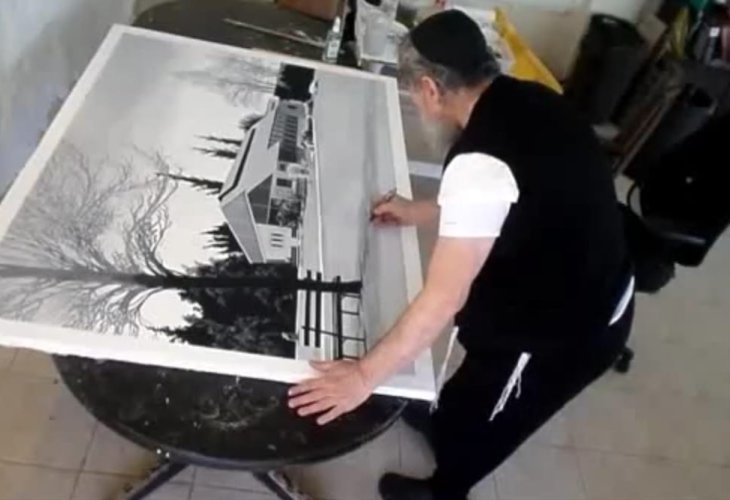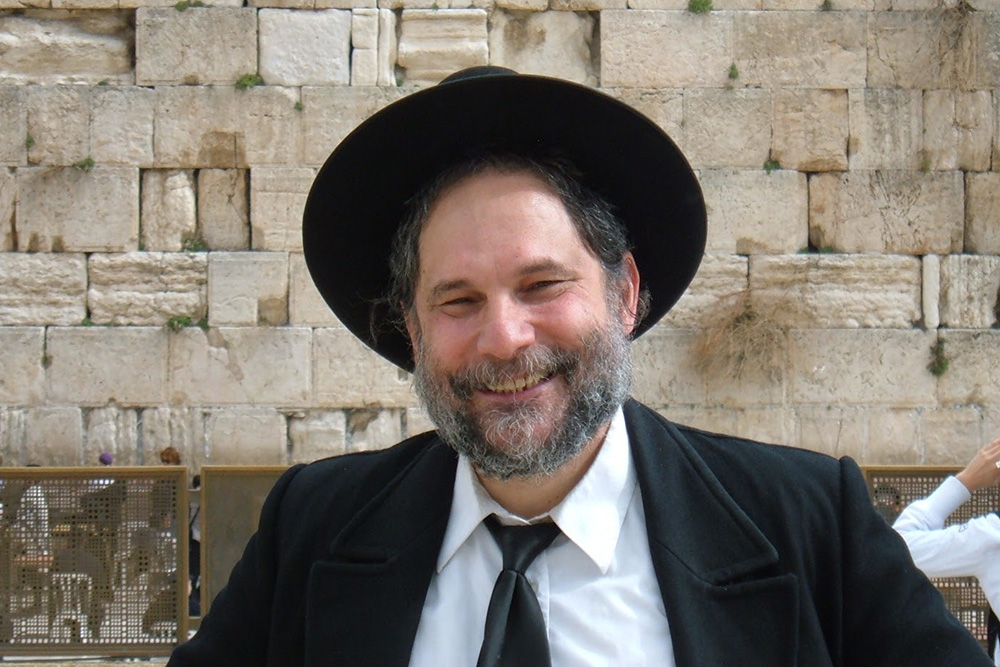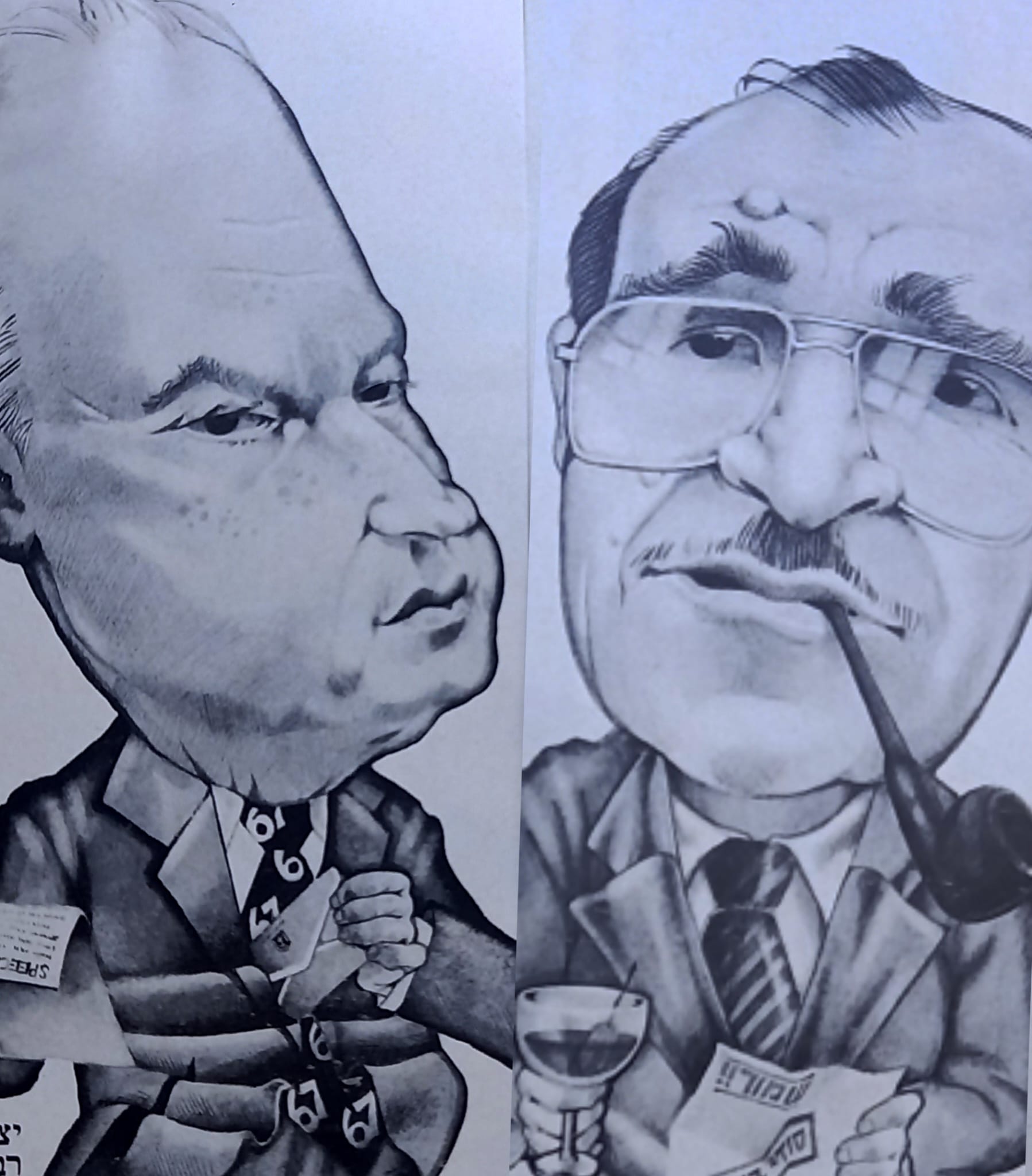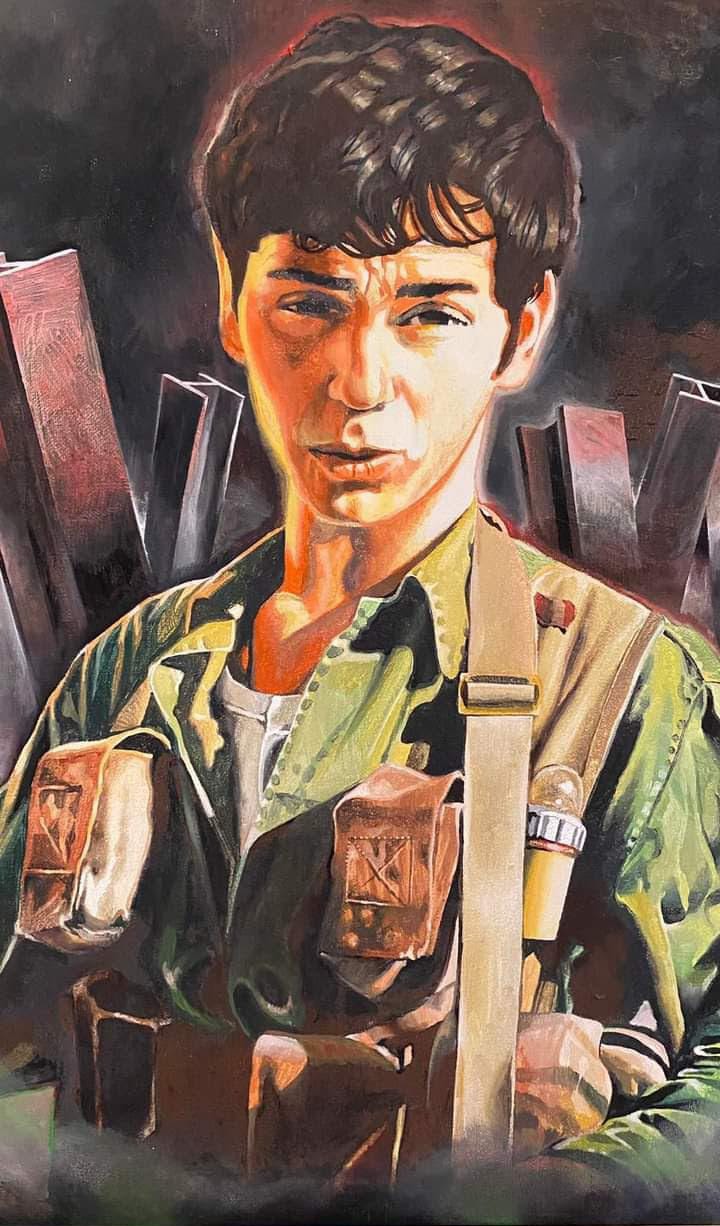The Press Artist Who Became a Torah Scholar: "It Happened All at Once, With No Gradual Transition"
Yair Enavi, one of the most famous press illustrators of the 1970s, unexpectedly left everything behind to pursue a life dedicated to Torah and mitzvot. Today, after 42 years of learning in a kollel, he reveals the journey he underwent and why he continued to publish his artworks anonymously.
 Yair Enavi (today) with one of his paintings
Yair Enavi (today) with one of his paintingsWhen Yair Enavi returned to Israel after seven years of studying art and painting in Europe, he felt an urge to act, create, become famous, and showcase his painting techniques and skills on every possible platform.
It was the late 1970s. Then a 31-year-old bachelor, he was determined to make a mark in the nation's newspapers, rapidly entering one after another, showcasing his rare painting talents of the time. Magazines were in their infancy and were quite excited about the young talent who approached them. His works quickly became prominent on various newspaper pages, some gracing the covers, always accompanied by the signature of artist Yair Enavi. No one imagined then that this young and well-known artist would soon take his first steps into the world of Judaism and, not long after, leave the newspapers unexpectedly.
 Yair Enavi
Yair EnaviFrom the Kibbutz to the City
"I was born in 1949 at Kibbutz Einat in central Israel," Yair begins. "Throughout my childhood, I lived in a kibbutz environment, with all that it entailed. The first time I encountered a life different from the kibbutz was at age 15 when my family moved to the settlement of Shefeya near Zikhron Ya'akov. This transition significantly changed my life, as I felt my eyes truly opened, in a positive sense, of course. I was no longer in a small isolated bubble; I discovered other worlds around me. It was the first time I truly understood there were many people in the world, different from me, and that wasn't a reason not to get to know them.
"This awareness continued after my army service when I traveled to Europe to study art, graphics, and various design methods. But in reality, I learned a lot not only about the profession but about life overall, approaching everything without a critical eye, I managed to accept the diversity in humanity. It didn't bother me; on the contrary, it fascinated me."
Yet, during those days, he never imagined the great surprise awaiting him when he would be exposed to the growing ultra-Orthodox community in Israel.
"I wasn't familiar with or had met the ultra-Orthodox until much later," Yair notes. "As a child, I was entirely unaware of the need to observe commandments, as unfortunately, there was no connection to that in the kibbutz. We ate regular meals on Shabbat, without any *kiddush*, we marked holidays in ways far from the proper tradition, like the 'Sheaf Uplifting Ceremony' on Passover eve or dancing around the farm equipment on Shavuot. Even when I celebrated my bar mitzvah and received a bicycle as a gift, no one bothered to tell me about the great merit of laying tefillin.
"But when we left the kibbutz and began living a regular family lifestyle, my father surprised us by starting to perform *kiddush* every Friday night. I later learned that it was encouraged by my mother. On Shabbat, we would visit my paternal grandparents who lived nearby. Although they didn't host a proper Shabbat meal, they did acknowledge the Shabbat, giving us a sense of continuing tradition. As I became more exposed to mitzvot and holidays, I felt intrigued, but I still didn't know much about the ultra-Orthodox community."
After marrying, Yair lived with his wife in Ramat Gan, close to Bnei Brak. "We never considered entering Bnei Brak," he recalls, "We felt as if there was a delineated boundary between us and the residents of that religious city."
A Drastic Turn
One day changed everything when close neighbors invited Yair and his wife to join them for a Torah class in Bnei Brak. "Of course, we politely refused," he recalls, "We didn't think it would interest us, especially since a fascinating TV show we were following was scheduled that evening. But just before the show, we found out a major basketball game was on, so the show was canceled. Frustrated, I informed my wife I was joining the neighbors for the class. The main thing I remember from that class was that the rabbi's messages didn't penetrate my thick shell, but apparently, they sparked something. A week later, when the neighbors invited us to a seminar at a hotel in the north, we decided to go."
Yair emphasizes: "It's not like we thought much about it; we just liked the idea of a week-long holiday and didn't care much about what would be discussed in the lectures. We found ourselves attending our first seminar, listening to lectures on Judaism, singing Shabbat hymns with dozens of people around the table, and suddenly feeling as if something opened in our hearts."
 Characters drawn for a political article in 'Monitin' magazine, 1979. Right: Israeli Ambassador to the U.S. Simcha Dinitz; Left: Yitzhak Rabin
Characters drawn for a political article in 'Monitin' magazine, 1979. Right: Israeli Ambassador to the U.S. Simcha Dinitz; Left: Yitzhak RabinYair pauses to discuss his professional life: "After returning to Israel, I became one of the famous illustrators. Constant offers came my way, and I think there wasn't a newspaper where my illustrations didn't appear, glorified by my byline. This led me to fame, and suddenly I noticed people around me starting to respect and admire me, visiting not just out of courtesy but to touch the glory. The pay wasn't bad either."
"I'm not someone who chases after honor, I didn't seek it, but as an artist, I enjoyed my progress and seeing my paintings published. I continued illustrating for various platforms, but I also saw the less appealing side of the media industry. I met people unsure of themselves, unclear on what they were trying to convey in their articles, lacking any unified aim. This confusion deeply bothered me."
"Arriving at the seminar in the north, I felt I finally met people who knew precisely their path in life. I listened to lectures by rabbis who clearly explained what was right, what was wrong, what was allowed, and what was forbidden. I learned there was deceit and absolute evil, but also goodness and truth. By the end of the seminar, I was wearing a *kippah* and decided radically to leave everything, including my profession, to study in yeshiva."
"Very quickly, we began observing the commandments and decided to move to Jerusalem, where we thought it would be easier on our new path. During those days, I joined Ohr Somayach yeshiva and soon completely transformed into a Torah scholar. To this day, 42 years later, I continue to learn in a *kollel*, seeing it as the true fulfillment of my life's purpose."
Simply Getting Acquainted
You're talking about such a significant and drastic life change. Was it difficult for you?
"It might sound less flattering, but I honestly didn't feel any hardship. As I mentioned, I had transitioned through various frameworks at an early age - from kibbutz to city life, from Israel to abroad, exposed to many populations, making my personality more inclusive and flexible. From the moment I discovered Judaism and realized that's what I was seeking, the path became clear, progressing smoothly and naturally, as I never clashed heads with anyone. Therefore, in the process of returning to Judaism, everything flowed and was easy. I encountered no difficulty studying the Talmud or observing Shabbat. I have no doubt that Hashem showed me great kindness."
 Cover illustration for a book published once we lived in Jerusalem, around 1989
Cover illustration for a book published once we lived in Jerusalem, around 1989What about your wife?
"My wife also actively participated in our return to Judaism; we went through the process together, and I remember it as a period when both of us felt we had finally found what we were searching for. We weren't just wandering aimlessly in space; we finally had something to hold onto. We found it so appealing, leading us practically to a life of complete observance of Torah and mitzvot."
And professionally, did you stop drawing?
"In the initial years, I completely left the world of painting and dedicated myself solely to Torah study. Later, I heard that Rabbi Shach, of blessed memory, advised several individuals not to entirely abandon their profession but to consider how it could fit into their new lives. I decided to find a way to blend drawing with values and spirituality. Thus, for 15 years, from 1980 to 1995, my drawings appeared in virtually every children's Jewish book published in Jerusalem. However, unlike before, where I wanted my name prominently displayed under my artworks, in the Jewish books, I preferred my name not to be printed. I simply didn't see the significance. The only important thing was that the illustrations served their purpose, making Jewish concepts accessible to the children of Israel."
 Picture of a soldier who fell in the Jordan Valley helicopter disaster, 1977
Picture of a soldier who fell in the Jordan Valley helicopter disaster, 1977Now, decades later, Yair draws less frequently, but he carries messages that remain with him. "I often meet with people taking their first steps in Judaism and also with those still distant. I tell them one thing - it doesn't matter what side you choose and how your life will look, but you must get to know the ultra-Orthodox community. It's a group with immense dedication and care for others. They lack the constant competition and need to hurt or belittle. I remember myself as a teenager, always on guard, fearing at any moment a comment might be made that could trample me. Not necessarily out of malice, but disguised as camaraderie and joking. This feeling followed me like a heavy weight, deeply burdening me. Only when I joined the ultra-Orthodox society did I realize how far removed it is from all that, and even more - people repeatedly tried to help us, found us a home, and assisted with our integration. They were really there for us and drew us closer, with so much effort and dedication. Today, I feel privileged to belong to such a sector, and those who remain outside without getting acquainted are truly missing out."

